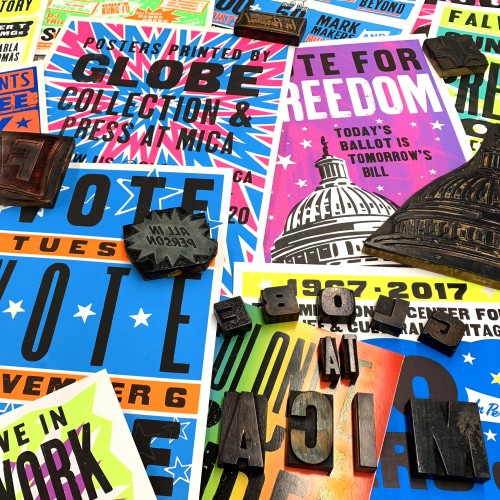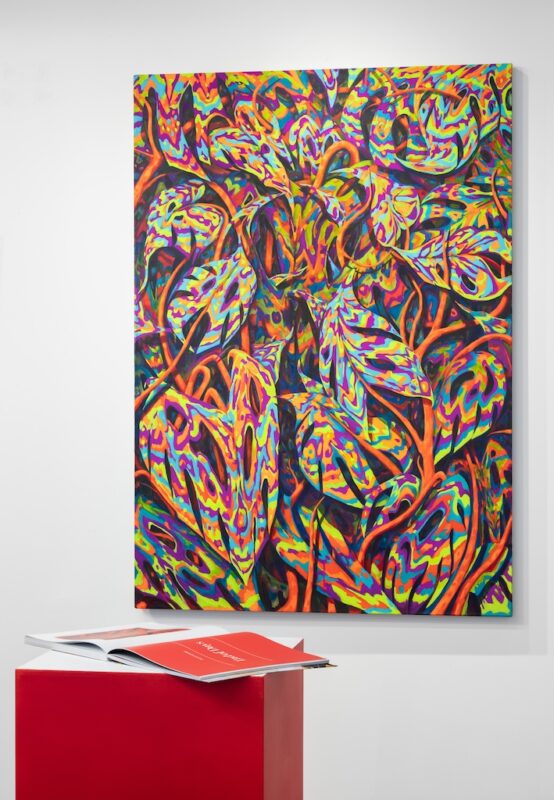Sticky sweet, gooey, delicious, and, even, pretty, this year’s Critics Picks at Maryland Art Place is difficult not to like. A harmonious color palette and a decadent approach to surface have combined here into an oddly pleasing and oddly comfortable slice of Baltimore and Washington’s top artistic offerings. This year’s critic, Robert Berlind, is a painter first, writer second, and this makes the whole exhibit make a lot of sense. There is a subtle emphasis on the visual over the conceptual, of more, rather than less. This year we have an even sampling of media and materials, but a return to the simpler things in a big way: all the works draw strength from the formal concerns of line, color, contrast, and texture.
Color Photos by Jaqueline Schlossman
Even the photography in the exhibit deals with issues of color, surface, and also the artifice in such concerns. Jaqueline Schlossman’s color photos, mounted onto aluminum, offer insight into the artifice of the modern landscape, as well as photography itself. The photographer shoots golf courses, an ironic and timely symbol of success in American culture. These quasi-faux landscapes are shot across the country, through a lens that is neither romantic or judgmental. Rather, they note odd contrasts between seemingly idyllic, natural landscapes with man-made modifications, and form a seamless entry into an exhibit where surface is everything.

Vincent Carney’s “Movie Theatre.”
Additional photography by Vincent Carney has a painterly, color-filled palette. We’ve all seen romantic photos of decay/peeling paint ennui, but this series of photos of defunct mental hospitals and other public spaces, with an ubiquitous aqua blue that is shockingly tropical, is so luscious that you want to take a second look. These photos are not attempting to be original or clever – they are about capturing found ‘paintings’ on film; color and light, surface and texture make for ample content.
Whether two or three dimensional, this decadent, yet simple, vision prevails, most notably in the other works in the front gallery. Jacquelyn Singer’s paintings and Timmerman Daugherty’s assembled sculptures offer an intense, jewel-like aesthetic, competing for our attention in a way that is unselfconscious, loud, and joyful. The basic themes of ‘red vs. green’ and ‘how much is too much?’ and ‘smooth vs. rough’ are at first simply nice, but then build towards a deeper, more gratifying place. Daugherty’s work is considered ‘outsider art’ and has been exhibited at AVAM, but the pristine white walls and the contemporary art context add dimension and weight to works which may seem, initially, merely fun and quirky.
Sculptures by Timmerman Daugherty.
Fiber Art, also known as quilts, by Catherine Kleeman.
Catherine Kleeman, like Dougherty, is another non-traditional choice in this exhibit. Her work consists of dyed fabric, embroidered stitching, with batting in the middle, otherwise known as quilts. What’s wrong with calling them quilts? Like the Gees Bend exhibit, and other popular movements to include ‘craft’ in the fine art family, Kleeman’s works seems at home here. Rich, layered color emanates from these irregularly shaped surfaces, as if the process of dyeing, as opposed to painting, embeds the color and surface. Awkwardly functional and not, these works assert themselves as virtual places, and offer a cushy space to think non-thoughts.
Paintings by Diane Szczepaniak.
The theme of color and light continues in the work of painters Isabel Manalo and Diane Szczepaniak, who both, quite differently, deal with the transformative powers of color. In the L-shaped compositions of Szczepaniak, weepy, liquid color vibrates the eyes in a way that would make Albers proud. These paintings, painted simply on paper with drizzley edges showing, acknowledge their strength through their limitations. The color-within-color compositions of Rothko are acknowledged, but Szczepaniak’s have more emphasis on optical, rather than emotional, weight. Paired with the Wallace Stevens poem “Sunday Morning,” which lovingly contrasts the eternal with the fleeting and momentary, I am not sure if I find the language ‘handle’ distracting or enriching. These paintings stand on their own without any sort of text, successfully transforming a flat surface into a hazy window, and edges into gradation.
Manalo, in front of ‘Friendly Fire.’
DC painter Isabel Manalo uses high key colors to transform scenes of violence and tragedy into pleasant gooey sensation. I am less interested in the content of these paintings than I am in their formal aspects. Manalo has the ability to create marks on a surface which seem to be generated by a natural, rather than human, hand. She also has the good sense to pair her high key colors with their absolute opposite – a raw canvas, or white, unprimed clayboard surface, creating the elbow room these marks need to be believable. At once flat and artificial, and at the same time, living, breathing entities, these paintings manage to charm, with their appealing candy-coated color and also repel, once you realize the secondary subject matter in each piece.
Viewers in front of Manalo’s paintings.
I’m not exactly sure how Dennis Farber’s photographs, all seemingly taken on the same afternoon in 1985 on a New Jersey pier relate to this exhibit. Each photo is ambiguous and slightly creepy. Bodies are cropped in impersonal ways and a chain link fence, and other metallic surfaces, seem to obscure our view, or push us back. The issue of surface and texture is present here, but there seems to be a conflict in vision – are these documentary shots which capture an event or personality or is the emphasis on formal visual issues? I do like that these digital photos were printed LARGE, at 39×49 inches, and pinned simply to the walls without a frame. Their size lends them an authority and a presence, but I haven’t decided it if the subject matter is a personal quirk or a formal experiment.
My favorite detail from the Farbers.
A video installation by Symmes Gardner is also a less obvious choice, although painterly issues of surface and layering are apparent. Multiple screens and T.V.’s show simultaneous clips from 50’s and 60’s movies, chosen for their lasting effects from the artist’s childhood. Rather than suggesting a narrative or memory, the clips hint at conflicts and setbacks, or of possible destruction. Writer Jason Fagan does an excellent job of explaining Gardner’s work and message and I would highly recommend reading this year’s catalogue, with writing by Darcie Bleau and Fagan.
The artists panel, moderated by Mark Alice Durant, discussed issues concerning the process of making art and also exhibiting it, and was worth attending. If you missed it, Radar Redux will be featuring a video version. All the artists were articulate and nobody said anything crazy. A heated discussion occurred, after an audience member asked about the importance of titles and ‘labels’ on work, which split the artists into differing camps.
Denny Farber offered the droll metaphor that: “Titles are like Xanax – they exist to decrease anxiety.” He continued, by explaining that,”They exist for those who need a handle to approach the work, but you, the viewer, have everything you need already.”
Catherine Keeman suggested that her titles were often lines of poetry, and functioned as “companions” for the work.
Jaqueline Schlossman countered that, “If the work doesn’t speak for itself, the artist isn’t doing their job.”
The issue of the necessity of words, of their weight and importance in the realm of visual arts, was mentioned by moderator Durant, who noted that the whole point of the panel, as well as the art criticism, is to do just that. Despite this, Durant criticized viewers who are unwilling to let go of verbal security.”We mistrust our experience,” Durant said. “We are trained to need categories and captions. Art is the one place where experience is uncategorized, and this creates anxiety for some. Especially in museums, I see people paying more attention to the captions or listening to the audio tour, than really seeing the work. Having a confrontation with a piece of art is a challenge because you are without language. We use language to negotiate the difference — between experience and knowledge.”
Eventually, the panel concluded that language is a double-edged sword, a necessary stumbling block, and a tool for clarity as well as misinformation. As Berlind noted in the catalogue, “the insights of a perceptive and articulate critic may well serve to open a viewer’s eyes and mind…,” while at worst a language handle can create a barrier to real engagement and looking. Berlind’s statement is paradoxical, in view of the user-friendly, process-based vibe of this show, but offers hope for a slow and visceral read. On multiple writers writing and multiple artists arting: “My hope is that having more voices addressing the art seen here will embolden viewers to form their own opinions, dispelling the notion of a single, authoratative interpretation.”
The exhibit is up from April twenty-second until May thirty-first. I suggest that you take Berlind’s invitation and come and see for yourself.
– Cara Ober
Reception after: Board Members Suzi Cordish and Barbie Hart with artist Laura Amussen.
Jacqueline Schlossman, Isabel Manalo, and an art fan.
Hadiah Shafie and Denny Farber.
Jack Livingston – Have a cupcake! Emily Hunter has got the goods.



